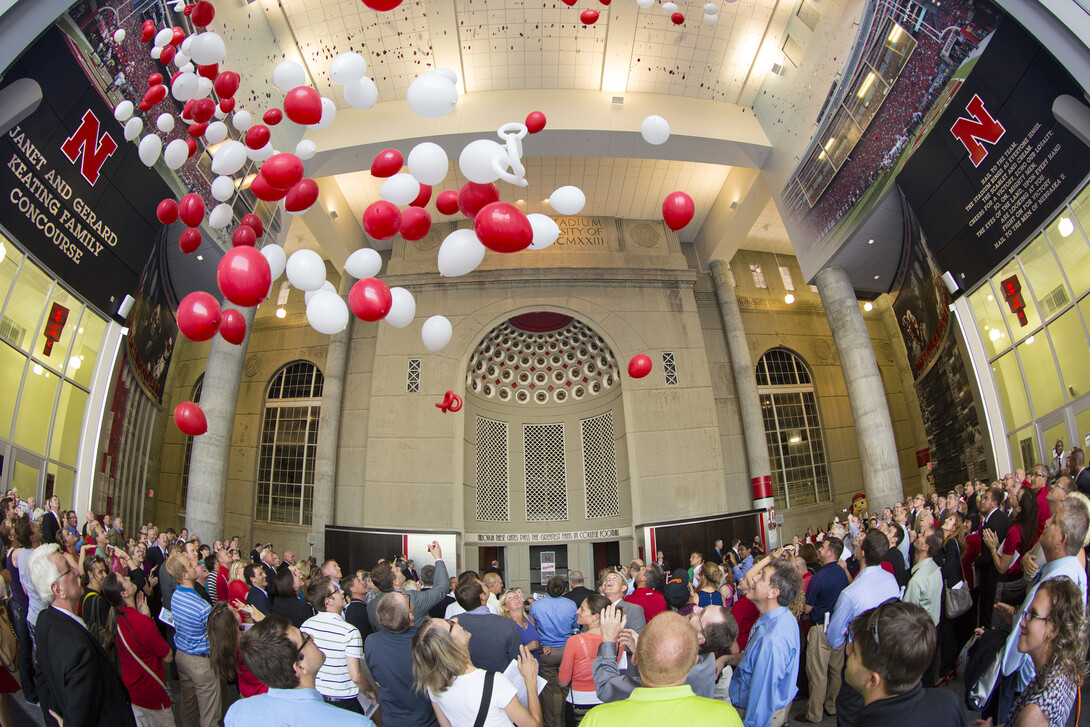
Mascots and fight songs, red-clad supporters and lots of cheering — just a typical day at Memorial Stadium, right?
However, it was anything but ordinary Thursday at the home of Cornhuskers football, as university officials, state and city leaders, representatives of the Big Ten Conference and supporters participated in a celebration for the historic expansion of Memorial Stadium’s east side.
UNL Chancellor Harvey Perlman, director of Athletics Shawn Eichorst, Athletic Director Emeritus Tom Osborne, Gov. Dave Heineman, University of Nebraska Regent Tim Clare and NU President James B. Milliken shared the honor of leading the festivities. For many in attendance, the Aug. 22 event was the first detailed look at the East Stadium Expansion project, a $63.5 million venture made possible primarily through private funds.
It has expanded and elevated the height of the stadium’s east side, added 6,000 new seats, 38 suites and a new club level, and will increase Memorial Stadium’s average attendance to more than 91,000.
In fact, Eichorst told those in attendance, the expansion marks the first time new non-premium football season tickets have been available to the general public for purchase between the 20-yard lines since Memorial Stadium was built 90 years ago.
“The East Stadium addition is a tribute to the dedication of our fans and generous contributions from our donors,” he said. “These elements have come together to enable us to add to the stadium’s capacity as well as to enhance the fan experience.”
But the expansion doesn’t stop with the added seats: East Memorial Stadium also will house a more than 50,000-square-foot, first-of-its-kind center of innovation that integrates UNL’s athletic and research endeavors. Located inside the expansion near Gate 20, the Center for Brain, Biology and Behavior (CB3) will house UNL researchers who are at the forefront in the study of genetics, neuroscience, physiology, cognition and other areas of brain science. The center will feature state-of-the-art brain imaging technologies for UNL faculty from an array of fields.
Concussion research is a cornerstone of the work at the center, which will be occupied later this fall by UNL researchers. Dennis Molfese, an international expert in brain imaging, and other UNL researchers are studying how the brain functions and processes information before and after concussions. Their focus is on athletes, but research could improve treatment for other head injuries. Annually, 10.1 million Americans suffer traumatic brain injuries.
A few steps to the north is the Nebraska Athletic Performance Laboratory, which also will be ready for use later this fall. The NAPL is poised to become a world-leading research and educational center that will enhance the performance, safety, health and well being of student-athletes. The NAPL team, led by Judith Burnfield, unites researchers from diverse clinical and scientific backgrounds with industry partners and academic colleagues from across the nation.
Cutting-edge technology will be used to assess the impact of training interventions on athletic performance. Other work will focus on identifying factors that help predict injuries or chronic conditions later in an athlete’s life, with an ultimate goal of reducing this risk. While the research will focus on collegiate athletes, the novel technologies and interventions that emerge are expected to effect the lives of athletes across the ability and age spectrum.
The two research facilities are connected physically by a bridge and feature common working space to foster collaboration.
“This project has always been about more than football,” Eichorst said. “The foresight, passion and vision of Chancellor Perlman and Coach Osborne and the generous support of our fans and donors to create a state-of-the-art, research collaboration facility has put this university at the forefront of progress. The Center for Brain, Biology and Behavior and the Nebraska Athletic Performance Laboratory are critical in our continued pursuit of excellence and in improving the experiences of all of our students.”
Perlman said the uncommonly strong partnership between athletics and academics was at the heart of the celebration.
“The new research facilities housed within the East Stadium represent a point of strength few universities can claim: a true collaborative partnership between academics and athletics,” Perlman said.
The Huskers will play their first game in the newly expanded stadium Aug. 31 against the University of Wyoming. Public tours will be 5 to 9 p.m. Sept. 18.







